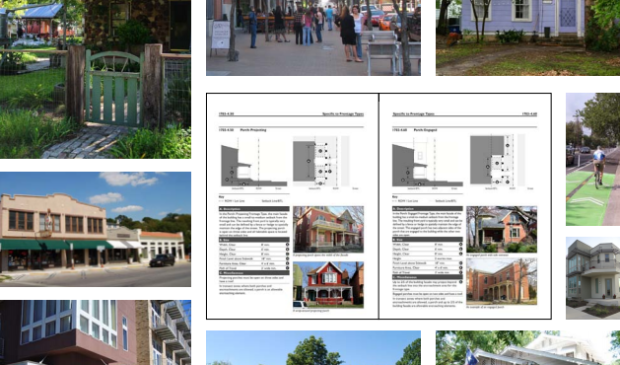Council delays vote to choose CodeNEXT process
Monday, October 27, 2014 by
Tyler Whitson After listening to opinions from staff, consultants and members of the public about how to move forward with the CodeNEXT process, City Council voted at a public hearing Thursday to keep all options on the table until it reopens the hearing and considers a decision at its Nov. 6 meeting.
In order for staff to continue with CodeNEXT — a formal rewrite of the city’s Land Development Code — Council must choose from three options that staff and consultants have proposed. In order from least to most comprehensive, those choices are a “brisk sweep,” “deep clean and reset” and “complete makeover” — referred to as Approaches 1, 2 and 3.
Staff and consultants recommend Approach 2, the deep clean and reset, a decision that the Planning Commission agreed with in late September.
Opticos Design Principal Daniel Parolek, whose firm is the city’s lead consultant for CodeNEXT, told the Austin Monitor that the recommended approach involves “basically throwing out the existing organizational structure of the Land Development Code, creating a new framework and a new operating system, and then creating a new code based on that.”
Parolek said the approach gives involved parties a chance to put the new system in place, learn it and try it out. “Once it’s tested and everybody understands it, it could fairly quickly get to a similar outcome that approach alternative 3 would, but it’s just more of a methodical, well-thought-out, systematic approach to get to that end outcome,” he said.
Steven Yarak of Austinites for Urban Rail Action, or AURA — which describes itself as a “group of community activists dedicated to an inclusive Austin” — advocated for the complete makeover and said the recommended approach is “insufficient to meet the number of problems that are called out in the Code Diagnosis,” a report that staff released on the current code in May.
“This decision has already been made,” Yarak said, asserting that the Imagine Austin comprehensive plan Council adopted in June 2012 calls for a complete makeover of the code. “If we roll out with this option 2, which only will apply to some limited areas of the city, we won’t realize the vision of Imagine Austin.”
According to backup documents, Approach 2 would incorporate an array of development review procedures and development standards into the new code, applying by-right review and form-based development standards more widely than in the current code.
Form-based development standards, which focus on the physical form of development and are often associated with encouraging walkability, would replace some of the existing Euclidean-based standards, which focus on use.
By-right review, which allows development applications that comply with zoning requirements to efficiently make their way through the application process, would replace some of the existing customized zoning and discretionary review.
Customized zoning requires the city to develop new and independent regulations for major projects, and discretionary review requires a review authority’s approval for certain projects.
In the complete makeover, form-based development standards and by-right review would be more widely applied initially than in the recommended approach.
Director and Legislative Chair of the Central Texas Commercial Association of Realtors Frank Harren said that the “conversation has drifted backward” since Imagine Austin was adopted. “Option 2 could lead to a very dangerous off-ramp in the implementation of what we’ve now spent more than five years trying to accomplish,” he said.
Harren contested Parolek’s assertion during the hearing that the complete makeover would likely require significantly more time and resources — at least six additional months — to accomplish than the recommended approach. Harren envisioned a scenario in which individual neighborhoods may choose not to opt in to the new standards and review procedures because they are concerned about their effects.
Parolek told Council that both approaches are viable options, but that “there’s an advantage to taking the systematic approach of adopting the code and testing the code.” He said he understands the concern that “if we take that first step and we test it, are we going to have the will to enable it to spread as aggressively as is necessary to implement Imagine Austin?”
Parolek assured Council that “a lot of time and energy would be put into building — as the code is being written — the support and understanding of that new code so that we do everything that we possibly can … to enable the code to spread.” That is no guarantee, Parolek admitted, but he said it has been effective in other communities.
“There’s some belief out there that the process is going to get rid of neighborhood plans. That’s not an intent,” Parolek continued. “This process will be using the neighborhood plans as a fundamental aspect in giving us guidance for this process.”
Once Council votes on a preferred CodeNEXT approach, the next step will be for the new Council to affirm the decision early next year.
If all goes according to plan, Parolek said, staff and consultants will begin the code rewrite process in early 2015, introduce the new draft in late 2015, adopt a draft in late 2016 and begin the mapping process in late 2016 or early 2017. The entire process, he said, will include extensive public input.
You're a community leader
And we’re honored you look to us for serious, in-depth news. You know a strong community needs local and dedicated watchdog reporting. We’re here for you and that won’t change. Now will you take the powerful next step and support our nonprofit news organization?









